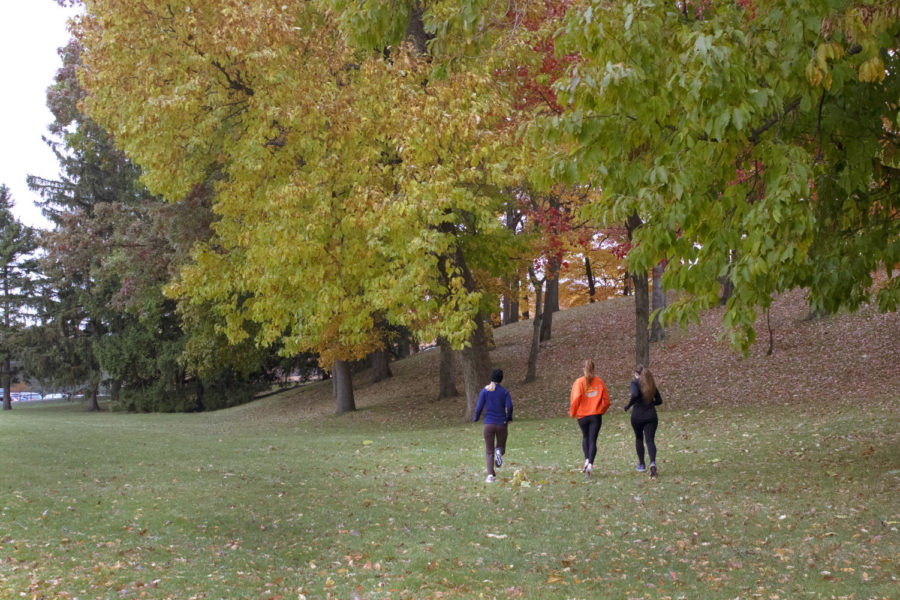welcome to running season
kent state running club members katie smith, sydney stevenson and elizabeth heeke // photo by alyssa coyle
With the changing of the seasons comes falling leaves, cozy weather, and pumpkin spice. It also brings cross-country season to competitive distance runners. Even if you aren’t an athlete, running causally has plenty of wellness benefits, and there is no better place to start than in the crisp fall weather.
Running is widely recognized as a healthy activity. It builds strong bones, strengthens muscles, improves cardiovascular wellness and also boosts self-confidence and improves mental health. Incorporating running or jogging into your life is a wonderful idea if you find a passion for it. Kent State Running Club members Bobby McDonald, a freshman exercise science major, and Isaac Balistreri, a freshman aerospace engineering major, both offered information for those who wish to start running safely and efficiently.
McDonald has a 5K personal record of 16:38, and specialized in the 800, 1600, 3200, 4×4 and 4×8 relays in high school. Balistreri has a personal record of 4:33 in the 600 M, and made regionals in the 3200 for track, and regionals for cross country while in high school. Both are continuing to hone their craft while in college, and are involved in the Kent State Running Club, which is always open to new members.
Luckily, Kent is a wonderful place to run. Anywhere on campus could work (as long as you’re mindful of pedestrians!). The city of Kent boasts the Portage County Trail as an alternative spot for those who’d like to get away from home for a little while. With plenty of options, you’ll find a perfect spot that you can claim as your favorite path. Just be careful when selecting the path that’s right for you, ensure it’s appropriate for runners and doesn’t present any major risk (especially if running alone). Somewhere relatively populous is a safe choice, so you’ll be able to get help from passersby should an accident occur.
Plenty of water is essential. It’s better to err on the side of too much water, at risk of feeling bloated, than too little, as dehydration leads to cramping, light-headeness or dizziness and a general hindrance in body function. Sixteen fluid ounces of water is a typical recommendation for athletes, so around this amount will be optimal from the time you start running to the time you finish.
“Base your water intake on how you feel,” Balistreri said. “Water need is based on the individual’s level of experience, so you decide what’s essential to your body.”
Additionally, McDonald recommends runners avoid carbonated drinks and instead eat food with little to no taste before a run, so you won’t feel sick while running. It’s also best to eat food high in carbs hours in advance, so you have energy but don’t feel full.
Balistreri recommends a balanced diet to improve wellness in general, which makes running easier altogether. It’s also wise to have a pre-run ritual meal your body is used to digesting, so your digestive system isn’t too overworked
Good examples of foods to eat before a run include oatmeal, bananas, English muffins, toast and bagels. You can put something like peanut butter—which is high in protein—Nutella or a little bit of reduced-fat cream cheese on your bagel or English muffin, just remember to keep it light and keep it nutrient dense.
Foods that should be avoided include onions, protein or fatty foods (only before a run, after a run they are optimal) and food with plenty of fiber. Salads are shockingly not the smartest choice pre-run. It’s best to eat something you know won’t leave your stomach too quickly. Following your run, you should have foods high in protein like beans, meat or even just a protein bar. You’ll also want plenty of electrolytes to replenish your body’s usual supply, especially on a hot day, if you’ve been sweating a lot. Always remember, what works for you works for you. You know your body better than anyone!
Before a workout of any kind, stretching must be done or your risk of injury increases dramatically. Before a workout, you should do plyometric stretches, meaning faster and more active stretches done in motion. This is the opposite of static stretching, which entails more time spent in one position. Static stretches before a workout increase the risk of injury, so they should always be done after a workout. It’s important to stretch every leg muscle and tendons too. This list includes (but is not limited to) glutes, hamstrings, thighs, calves, shins, ankles, achilles tendons and hips.
McDonald warns to be especially vigilant of your hamstrings and your abductors, which are common areas for injury that runners face. He explains that an injury of either body part can incapacitate you for two to six weeks.
“I’d say being able to touch your toes, or at least reach for them is a most necessary stretch goal before you start running, to reduce the risk of injury,” McDonald said.
Good stretches for pre-workout include standing quad stretch, lunges (both forward and to the side), hamstring/calf stretch, standing hip flexor stretches, standing iliotibial stretch, calf raises, lateral swings, high knees and butt kicks. These stretches should all be dynamic, meaning your joints and muscles go through a full range of motion.
Our runners tell us it’s also important to stretch your back before a run, as running isn’t an isolated exercise. Pay attention to your entire body. It’s wise to practice these stretches after watching instructional tutorials online, so your form is done correctly and safely.
Post workout stretches should be focused on the same area, but instead of plyometrics, do static stretches. All of the stretches listed above should be done again, only they should be made static instead of dynamic. Additionally, a leg roller or elastic band can help stretch your legs after running to prevent injury. Remember, stretch well and stretch every time.
Form and technique are also crucial for successful and safe running. When running, your leg should land perpendicular to the ground, and you want to land on your mid-foot, not your heel. You want your strides per minute to be in a range from 160 to 190, depending on your height.
“Keep your body in one big fluid motion, make sure the swinging of your arms, your breathing and your feet hitting the ground are all in sync,” McDonald said.
Balistreri recommends watching videos of professional runners and mimicking their form. He also recommends to relax your face while running, lift your knees specifically and maintain good posture.
“Everyone’s form looks different, because everyone has different body types, so don’t go against your natural form just because of what someone else does,” Balistreri said. “There are some key movements you have to use, but if your form isn’t exactly like everyone else, you shouldn’t stress out about it.”
Mental work is a large part of running, especially as a beginner. McDonald recommends accepting that becoming a skilled runner takes time and practice.
“It requires discipline, time and lots of mistakes to get to a point where you’re confident in your ability,” McDonald said.
If you choose, you can use a stopwatch to track your mileage, but you don’t necessarily need to do that right away. You can always run until you feel like stopping, not just until you’ve reached a designated goal. Whatever makes you comfortable is going to be the right choice for you. Music can help take your focus off of the physical strain, and can also hype you up a little.
Still, don’t push too hard. Know your limit and increase your training at a steady rate, depending on your previous fitness experience. You can start with walking if running is too intimidating, and progress to jogging, perhaps incorporating some jogging into your walking at the beginning. Eventually, you’ll be running miles, but you should never feel like your progress is too slow. The pace you set is the right pace. So get to running, because it just might be the path for you!
Support Student Media
Hi, I’m Catie Pusateri, the Editor-in-Chief of A Magazine. My staff and I are committed to bringing you the most important and entertaining news from the realms of fashion, beauty and culture. We are full-time students and hard-working journalists. While we receive support from the student media fee and earned revenue such as advertising, both of those continue to decline. Your generous gift of any amount will help enhance our student experience as we grow into working professionals. Please go here to donate to A Magazine.











